Effect of Macroscopic Turbulent Gust on the Aerodynamic Performance of Vertical Axis Wind Turbine
Abstract
:1. Introduction
2. Problem Statement
3. Numerical Methodology
3.1. Wind Inlet Conditions
3.2. Computational Domain and Grid
3.3. Computational Methodology
4. Validation and Grid Independence
5. Results and Discussion
5.1. Effect of Randomisation Parameters on the VAWT Performance
5.1.1. Effect of Randomised Fluctuation
5.1.2. Effect of Randomisation Update Frequency
5.2. Effect of Tip Speed Ratio on Coefficient of Power
5.3. Turbine Wake Study
5.4. Effect of Gust Amplitude on the VAWT Performance
5.5. Effect of Gust Time Period on the VAWT Performance
6. Conclusions
- The effect of inlet velocities randomisation parameters such as input randomised fluctuation of 6 m/s, 4 m/s, and 2 m/s were investigated. The average Cp value and magnitude of fluctuation of velocity was higher, with an increase in the magnitude of randomised fluctuation.
- The effect of randomisation update frequencies of 45, 90,180, and 360 time-steps was also studied. There was a decrease in the magnitude of velocity fluctuations from the update frequency 360 time-steps to the update frequency of 45 time-steps. The flow field upstream of the turbine was more uniform for the update frequency of 45 time-steps than for the update frequency of 360 time-steps, which is characterised by a higher magnitude of macro-turbulence. As the update interval decreases, the flow field in front of the turbine becomes uniform. The magnitude of Cp fluctuations also decreases with the size of the update interval.
- The effect of the tip speed ratio on a wind turbine for randomised inlet conditions was also studied. The magnitude of fluctuation of velocity also decreased with an increase in tip speed ratio. Though randomised and uniform flow follows the same Cp-λ trend, the slope was steeper for randomised, and there was a visible difference in the Cp values at λ = 2.5 and λ = 5.3. The performance of the VAWT was highly sensitive at higher tip speed ratios. Thus, the operational range of tip speed ratio to extract maximum power from available wind should be around 4.1 for a 2 bladed turbine of 1 m diameter and solidity of 0.12.
- The variation of Cm given for a single blade for a rotor rotation for various tip speed ratios was also studied. It was noticed that at lower tip speed ratios, the peak Cm occurred before 90° and a drop in moment coefficient to negative values after dynamic stall was observed. During downstream conditions, vortex shedding from the central shaft contributed to higher moment coefficient values and larger variations for λ = 2.5 compared to other tip speed ratios.
- The effect of tip speed ratio on the turbine wake recovery was also studied. As the tip speed ratio increased, the velocity deficit in the wake structure also increased. Streamwise velocity behind the turbine was highly reduced. For near wake cases, x/d = 2.5 and x/d = 4, the velocity deficit values were comparable for all tip speed ratios. As the downstream distance increased, the velocity deficit decreased for all tip speed ratios. Wake recovery was faster in the case of lower tip speed ratios. Wake generated by uniform velocity inlet had slower wake recovery compared to randomised velocity inlet. Macro-turbulence generated by randomisation enhanced the mixing of flow downwind of the turbine, allowing faster recovery.
- Further, a study was performed on the influence of gust parameters such as gust amplitude and gust time period on the coefficient of power of the VAWT, for an IEC extreme operating gust. Since the average gust factor is 1.44 in extreme cases, 4 different randomised cases of Ugust = 6 m/s, 8 m/s, 10 m/s, and 12 m/s with gust factors of 1.34, 1.50, 1.64, and 1.80, respectively, were considered. A comparison of U∞ for uniform gust cases and randomised gust cases showed that the spatial fluctuation in the velocity profile of randomised gust subsequently affected the Cp values of the wind turbine. The tip speed ratio vs. flow time plots also showed fluctuations for all gust cases. Unlike the case with a steady inlet velocity of 10 m/s, the Cm vs. azimuthal angle for Ugust deviated from the general profile due to continuously varying tip speed ratios. The deviation occurred for turbine cycles where free stream velocity was greater than 14 m/s, i.e., the tip speed ratio was less than 2.92. This was clearly observed in gust cases with higher gust magnitude, Ugust = 10 m/s and Ugust = 12 m/s. As tip speed ratios increased, cycles had a lower value of peak Cm during the upwind condition and Cm values were not negative.
- The effect of time period was investigated for Ugust = 10 m/s, and gust factor 1.64 was studied for gust time periods T = 3 s, 6 s, 10.5 s. All cases showed similar values of maximum and minimum velocities and tip speed ratios, spread over the respective time periods. The Cp plot for 10.5 s gust showed many fluctuations in the region where velocity rises to the maximum.
Author Contributions
Funding
Data Availability Statement
Acknowledgments
Conflicts of Interest
References
- Kusch-Brandt, S. Renewables 2019 Global Status Report. 2019, Volume 8. 9783981891140. Available online: https://www.ren21.net/wp-content/uploads/2019/05/2018-2019-Annual-Report_FINAL_low-res.pdf (accessed on 12 January 2023).
- Emejeamara, F.C.; Tomlin, A.S.; Millward-Hopkins, J.T. Urban wind: Characterisation of useful gust and energy capture. Renew. Energy 2015, 81, 162–172. [Google Scholar] [CrossRef] [Green Version]
- Johari, M.K.; Jalil, M.A.A.; Shariff, M.F.M. Comparison of horizontal axis wind turbine (HAWT) and vertical axis wind turbine (VAWT). Int. J. Eng. Technol. 2018, 7, 74–80. [Google Scholar] [CrossRef] [Green Version]
- Pagnini, L.C.; Burlando, M.; Repetto, M.P. Experimental power curve of small-size wind turbines in turbulent urban environment. Appl. Energy 2015, 154, 112–121. [Google Scholar] [CrossRef]
- Toja-Silva, F.; Colmenar-Santos, A.; Castro-Gil, M. Urban wind energy exploitation systems: Behaviour under multidirectional flow conditions—Opportunities and challenges. Renew. Sustain. Energy Rev. 2013, 24, 364–378. [Google Scholar] [CrossRef]
- Ishugah, T.F.; Li, Y.; Wang, R.Z.; Kiplagat, J.K. Advances in wind energy resource exploitation in urban environment: A review. Renew. Sustain. Energy Rev. 2014, 37, 613–626. [Google Scholar] [CrossRef]
- Tummala, A.; Velamati, R.K.R.K.; Sinha, D.K.; Indraja, V.; Krishna, V.H.; Subramanian, A.; Yogesh, S.A.; Sivanandan, H.; Giri, A.; Vasudevan, M.; et al. Progress and recent trends of wind energy technology. Renew. Sustain. Energy Rev. 2013, 21, 456–468. [Google Scholar] [CrossRef]
- Britter, R.E.; Hanna, S.R. Flow and dispersion in urban areas. Annu. Rev. Fluid Mech. 2003, 35, 469–496. [Google Scholar] [CrossRef]
- Mantravadi, B.; Unnikrishnan, D.; Sriram, K.; Mohammad, A.; Vaitla, L.; Velamati, R.K. Effect of solidity and airfoil on the performance of vertical axis wind turbine under fluctuating wind conditions. Int. J. Green Energy 2019, 16, 1329–1342. [Google Scholar] [CrossRef]
- Tavernier, D.D.; Ferreira, C. The need for dynamic inflow models for vertical axis wind turbines. J. Phys. Conf. Ser. 2019, 1356. [Google Scholar] [CrossRef] [Green Version]
- McIntosh, S.C.; Babinsky, H.; Bertényi, T. Optimizing the energy output of vertical axis wind turbines for fluctuating wind conditions. In Proceedings of the Collect Tech Pap—45th AIAA Aerospace Sciences Meeting, Reno, NV, USA, 8–11 January 2007; Volume 23, pp. 16202–16214. [Google Scholar] [CrossRef]
- Wekesa, D.W.; Wang, C.; Wei, Y.; Danao, L.A.M. Analytical and numerical investigation of unsteady wind for enhanced energy capture in a fluctuating free-stream. Energy 2017, 121, 854–864. [Google Scholar] [CrossRef]
- Battisti, L.; Benini, E.; Brighenti, A.; Soraperra, G.; Castelli, M.R. Simulating the dynamic behavior of a vertical axis wind turbine operating in unsteady conditions. J. Phys. Conf. Ser. 2016, 753. [Google Scholar] [CrossRef]
- Bhargav, M.; Kishore, V.R.; Laxman, V. Influence of fluctuating wind conditions on vertical axis wind turbine using a three dimensional CFD model. J. Wind Eng. Ind. Aerodyn. 2016, 158, 98–108. [Google Scholar] [CrossRef]
- Wekesa, D.W.; Wang, C.; Wei, Y.; Kamau, J.N.; Danao, L.A.M. A numerical analysis of unsteady inflow wind for site specific vertical axis wind turbine: A case study for Marsabit and Garissa in Kenya. Renew. Energy 2015, 76, 648–661. [Google Scholar] [CrossRef]
- Bausas, M.D.; Danao, L.A.M. The aerodynamics of a camber-bladed vertical axis wind turbine in unsteady wind. Energy 2015, 93, 1155–1164. [Google Scholar] [CrossRef]
- Danao, L.A.; Edwards, J.; Eboibi, O.; Howell, R. A numerical investigation into the influence of unsteady wind on the performance and aerodynamics of a vertical axis wind turbine. Appl. Energy 2014, 116, 111–124. [Google Scholar] [CrossRef] [Green Version]
- Danao, L.A.; Eboibi, O.; Howell, R. An experimental investigation into the influence of unsteady wind on the performance of a vertical axis wind turbine. Appl. Energy 2013, 107, 403–411. [Google Scholar] [CrossRef]
- Scheurich, F.; Brown, R.E. Modelling the aerodynamics of vertical-axis wind turbines in unsteady wind conditions. Wind Energy 2013, 16, 91–107. [Google Scholar] [CrossRef] [Green Version]
- Wu, Z.; Wang, Q.; Bangga, G.; Huang, H. Responses of vertical axis wind turbines to gusty winds. Proc. Inst. Mech. Eng. Part A J. Power Energy 2020, 235, 81–93. [Google Scholar] [CrossRef]
- Wu, Z.; Bangga, G.; Cao, Y. Effects of lateral wind gusts on vertical axis wind turbines. Energy 2019, 167, 1212–1223. [Google Scholar] [CrossRef]
- Rakib, M.I.; Evans, S.P.; Clausen, P.D. Measured gust events in the urban environment, a comparison with the IEC standard. Renew. Energy 2020, 146, 1134–1142. [Google Scholar] [CrossRef]
- Onol, A.O.; Yesilyurt, S. Effects of wind gusts on a vertical axis wind turbine with high solidity. J. Wind Eng. Ind. Aerodyn. 2017, 162, 1–11. [Google Scholar] [CrossRef]
- Kwon, D.K.; Kareem, A.; Butler, K. Gust-front loading effects on wind turbine tower systems. J. Wind Eng. Ind. Aerodyn. 2012, 104–106, 109–115. [Google Scholar] [CrossRef]
- Cheng, P.W.; Bierbooms, W.A.A.M. Distribution of extreme gust loads of wind turbines. J. Wind Eng. Ind. Aerodyn. 2001, 89, 309–324. [Google Scholar] [CrossRef]
- Bierbooms, W.; Cheng, P.W. Modelling of Extreme Gusts for Design Calculations. In Proceedings of the EUWEC 96, Göteborg, Sweden, 20–24 May 2000; pp. 842–845. [Google Scholar]
- Balduzzi, F.; Zini, M.; Ferrara, G.; Bianchini, A. Development of a computational fluid dynamics methodology to reproduce the effects of macroturbulence on wind turbines and its application to the particular case of a VAWT. J. Eng. Gas Turbines Power 2019, 141, 1–12. [Google Scholar] [CrossRef]
- KC, A.; Whale, J.; Urmee, T. Urban wind conditions and small wind turbines in the built environment: A review. Renew. Energy 2019, 131, 268–283. [Google Scholar] [CrossRef]
- Shahzad, A.; Asim, T.; Mishra, R.; Paris, A. Performance of a vertical axis wind turbine under accelerating and decelerating flows. Procedia CIRP 2013, 11, 311–316. [Google Scholar] [CrossRef] [Green Version]
- Jafari, M.; Razavi, A.; Mirhosseini, M. Effect of Steady and Quasi-Unsteady Wind on Aerodynamic Performance of H-Rotor Vertical Axis Wind Turbines. J. Energy Eng. 2018, 144, 04018065. [Google Scholar] [CrossRef]
- Lee, K.Y.; Tsao, S.H.; Tzeng, C.W.; Lin, H.J. Influence of the vertical wind and wind direction on the power output of a small vertical-axis wind turbine installed on the rooftop of a building. Appl. Energy 2018, 209, 383–391. [Google Scholar] [CrossRef]
- IEC Standard 61400-2; International Standard—Part 2: Small Wind Turbines. International Electrotechnical Commission: London, UK, 2006; Volume 2006, ISBN 2831886376.
- Stork, C.H.J.; Butterfield, C.P.; Holley, W.; Madsen, P.H.; Jensen, P.H. Wind conditions for wind turbine design proposals for revision of the IEC 1400-1 standard. J. Wind Eng. Ind. Aerodyn. 1998, 74–76, 443–454. [Google Scholar] [CrossRef]
- Lam, H.F.; Peng, H.Y. Study of wake characteristics of a vertical axis wind turbine by two- and three-dimensional computational fluid dynamics simulations. Renew. Energy 2016, 90, 386–398. [Google Scholar] [CrossRef]
- Peng, H.Y.; Lam, H.F.; Lee, C.F. Investigation into the wake aerodynamics of a five-straight-bladed vertical axis wind turbine by wind tunnel tests. J. Wind Eng. Ind. Aerodyn. 2016, 155, 23–35. [Google Scholar] [CrossRef]
- Rezaeiha, A.; Montazeri, H.; Blocken, B. Characterization of aerodynamic performance of vertical axis wind turbines: Impact of operational parameters. Energy Convers. Manag. 2018, 169, 45–77. [Google Scholar] [CrossRef]
- Daróczy, L.; Janiga, G.; Petrasch, K.; Webner, M.; Thévenin, D. Comparative analysis of turbulence models for the aerodynamic simulation of H-Darrieus rotors. Energy 2015, 1–11. [Google Scholar] [CrossRef]
- Rezaeiha, A.; Montazeri, H.; Blocken, B. On the accuracy of turbulence models for CFD simulations of vertical axis wind turbines. Energy 2019, 180, 838–857. [Google Scholar] [CrossRef]
- Rezaeiha, A.; Kalkman, I.; Blocken, B. CFD simulation of a vertical axis wind turbine operating at a moderate tip speed ratio: Guidelines for minimum domain size and azimuthal increment. Renew. Energy 2017, 107, 373–385. [Google Scholar] [CrossRef] [Green Version]
- Bianchini, A.; Balduzzi, F.; Bachant, P.; Ferrara, G.; Ferrari, L. Effectiveness of two-dimensional CFD simulations for Darrieus VAWTs: A combined numerical and experimental assessment. Energy Convers. Manag. 2017, 136, 318–328. [Google Scholar] [CrossRef]
- Castelli, M.R.; Englaro, A.; Benini, E. The Darrieus wind turbine: Proposal for a new performance prediction model based on CFD. Energy 2011, 36, 4919–4934. [Google Scholar] [CrossRef]




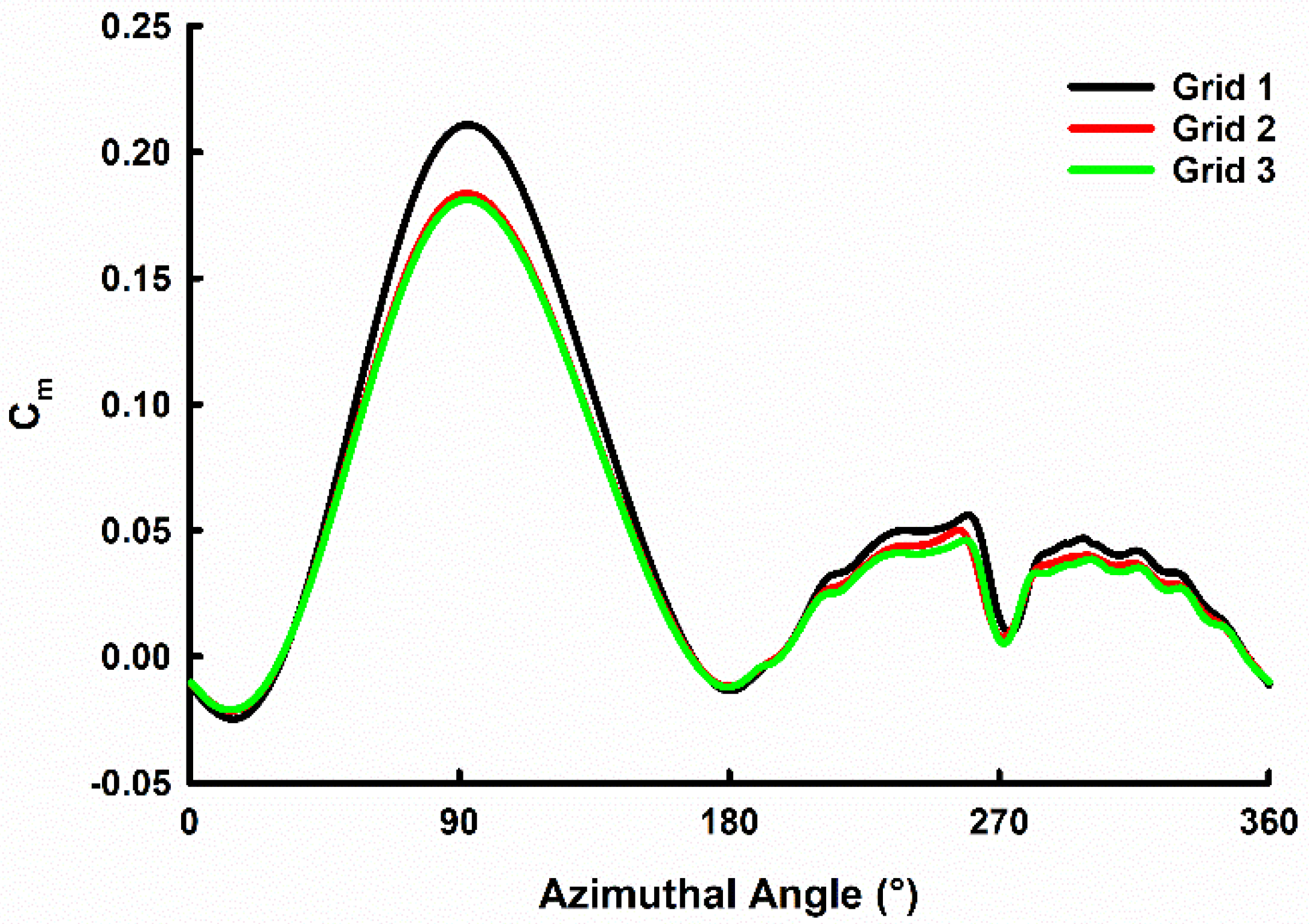

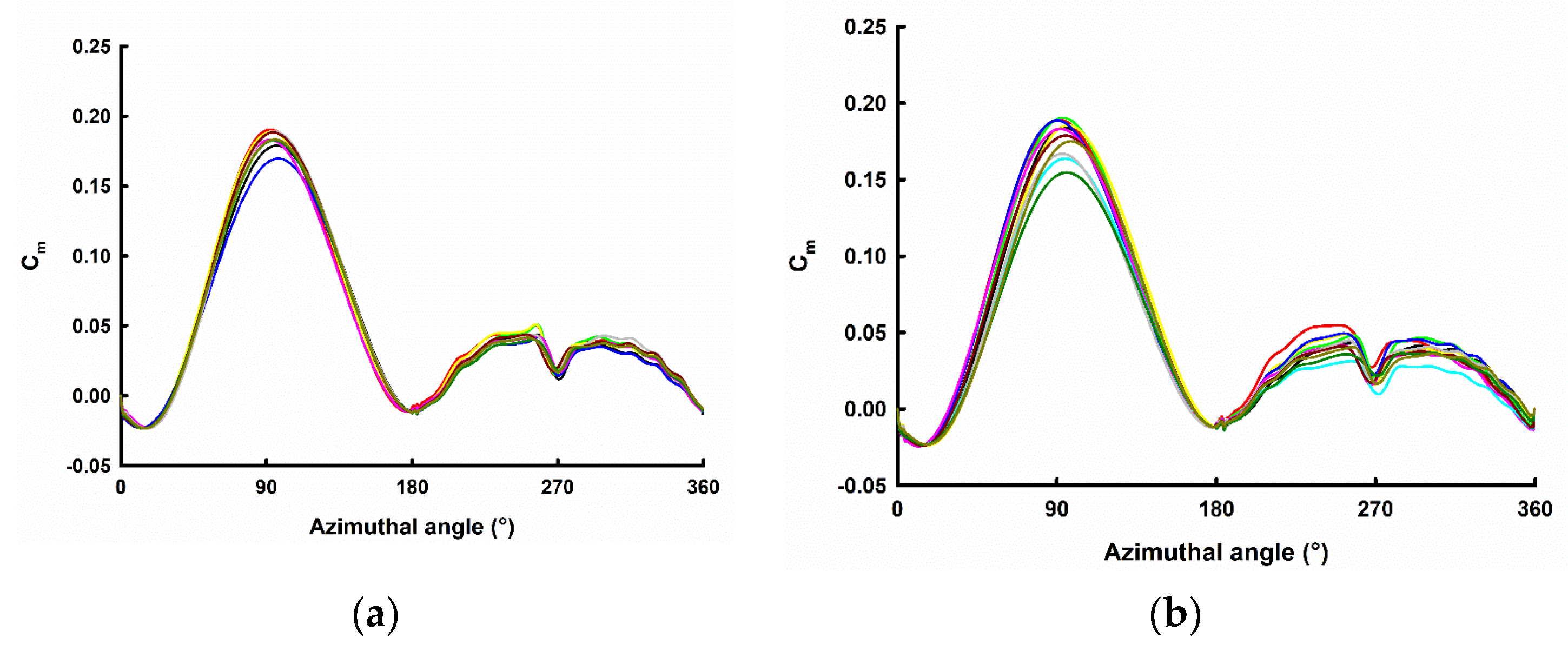


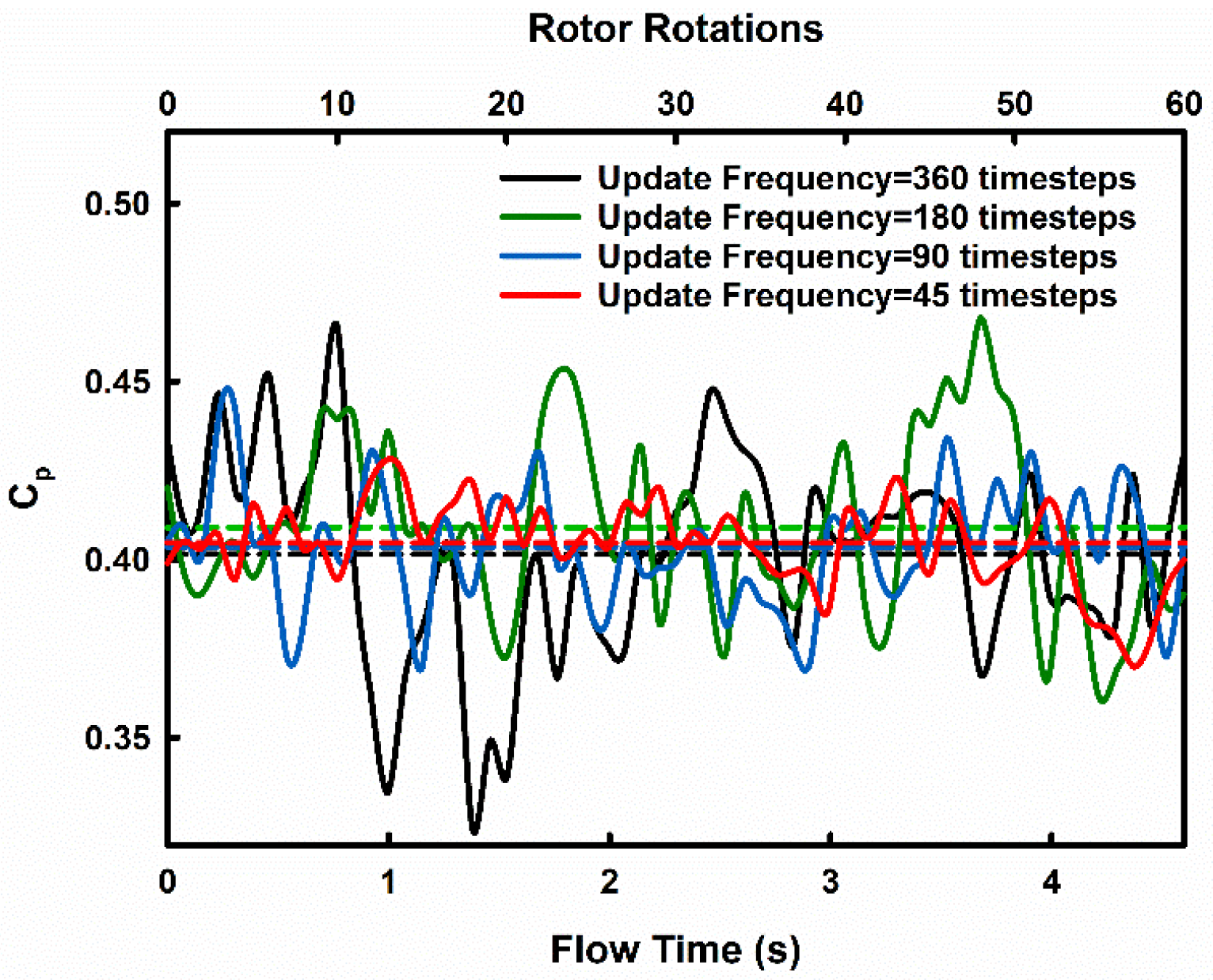
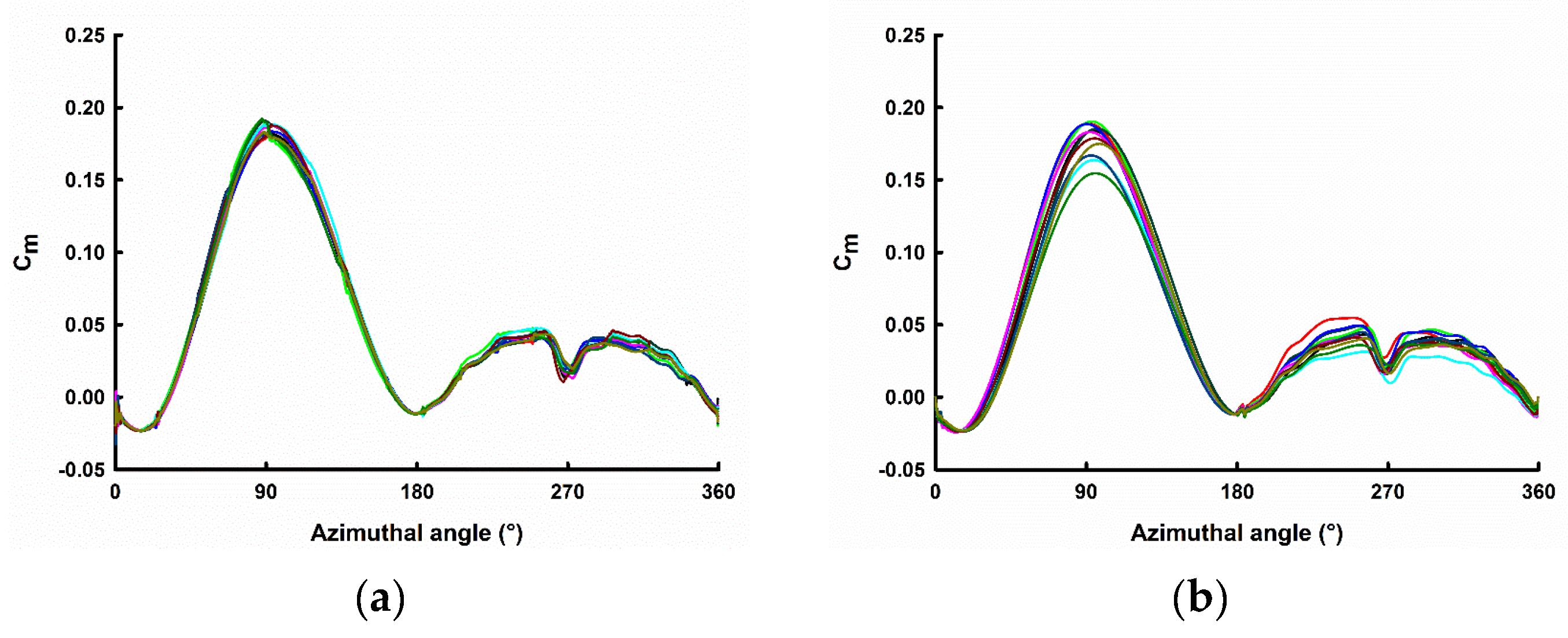


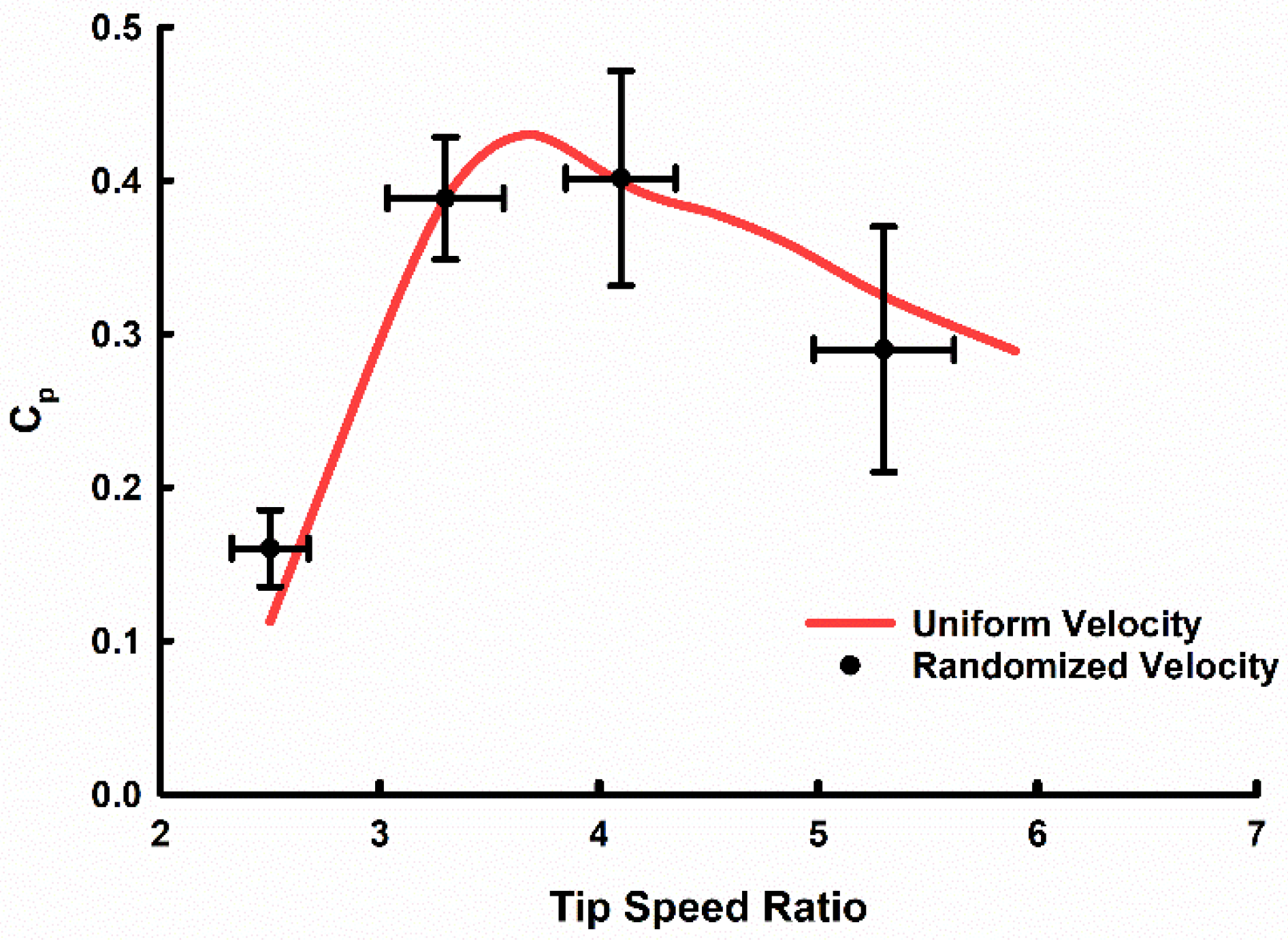





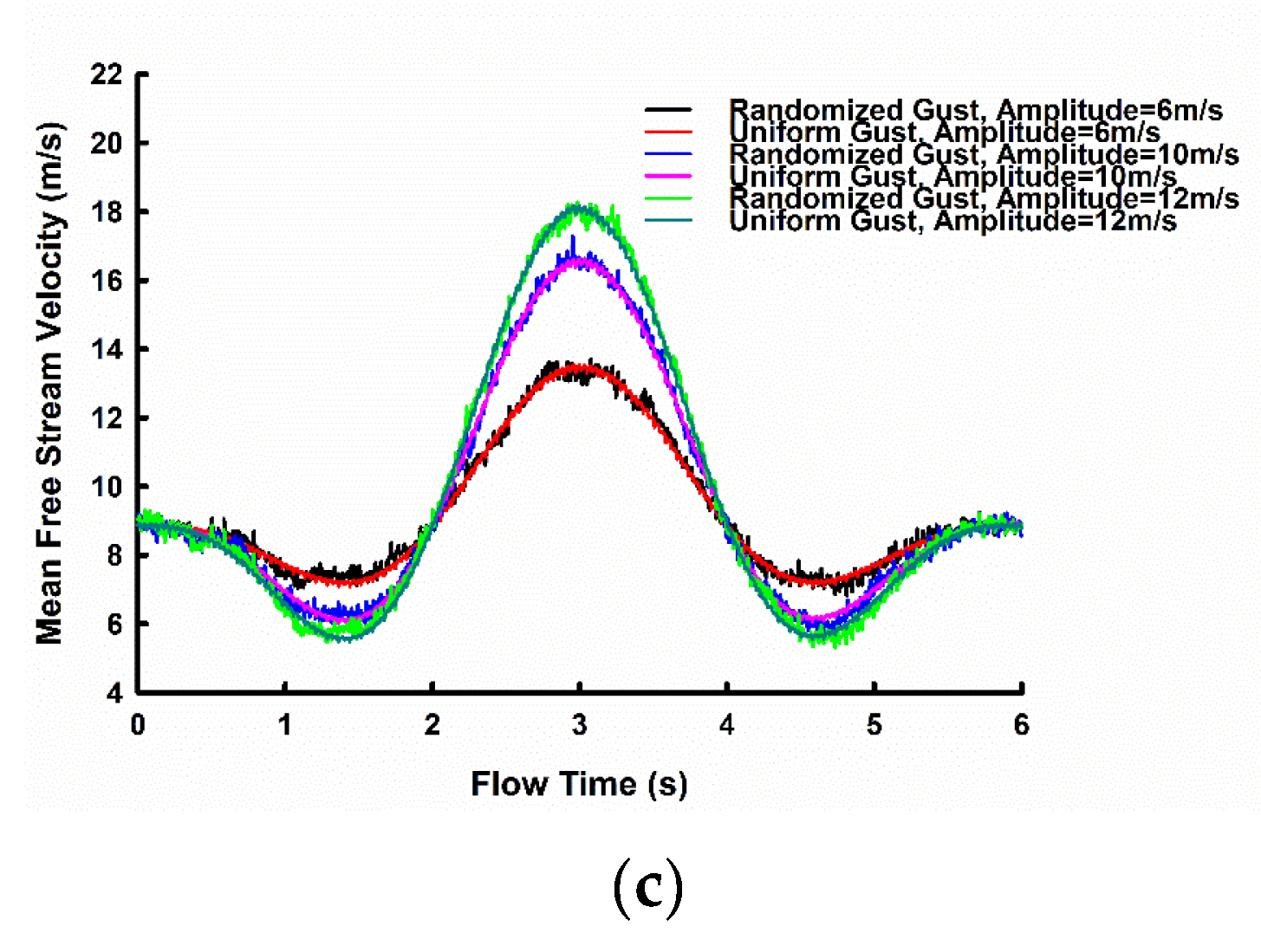



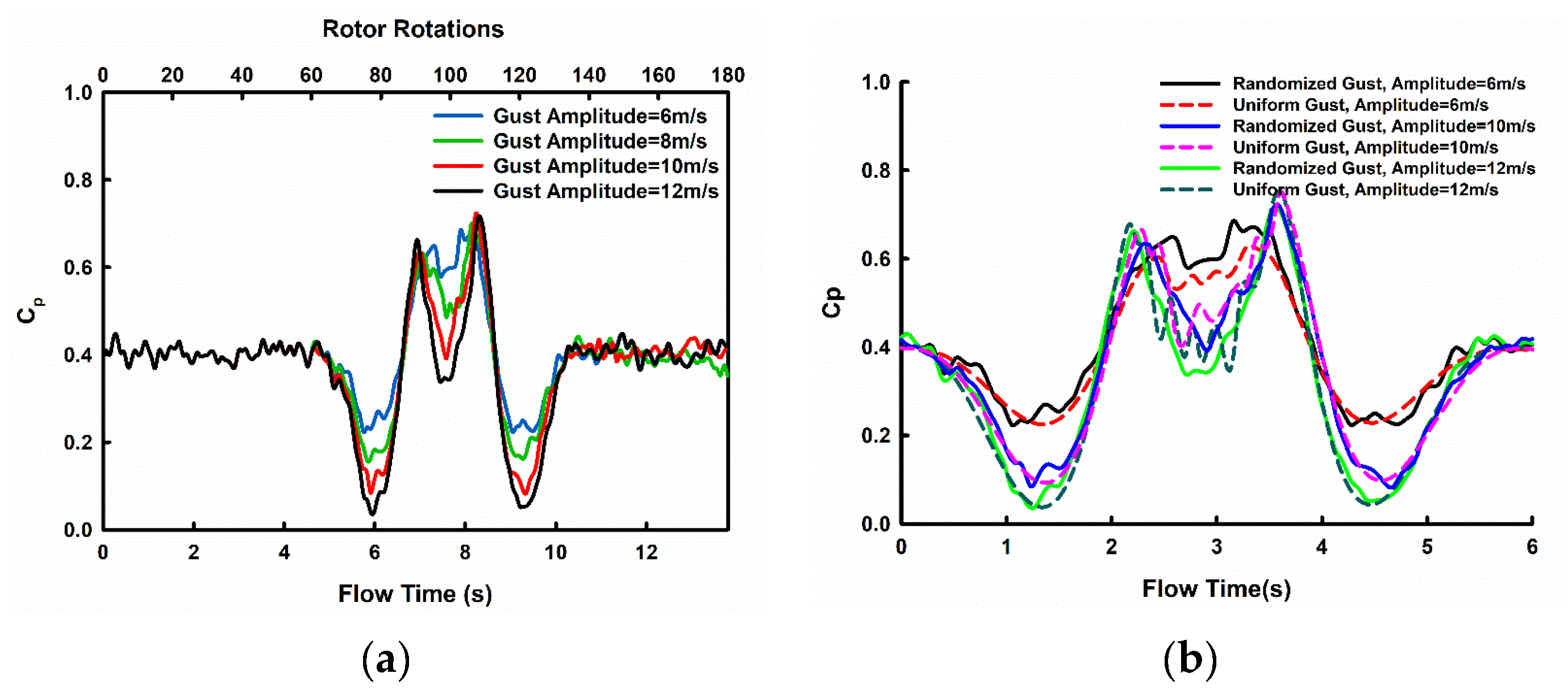





| Axis of Rotation | Vertical |
|---|---|
| Blade profile | NACA 0018 |
| Chord, c | 0.06 m |
| Diameter of rotor | 1 m |
| Frontal area of the rotor | 1 m2 |
| Solidity, σ | 0.12 |
| Number of blades | 2 |
Disclaimer/Publisher’s Note: The statements, opinions and data contained in all publications are solely those of the individual author(s) and contributor(s) and not of MDPI and/or the editor(s). MDPI and/or the editor(s) disclaim responsibility for any injury to people or property resulting from any ideas, methods, instructions or products referred to in the content. |
© 2023 by the authors. Licensee MDPI, Basel, Switzerland. This article is an open access article distributed under the terms and conditions of the Creative Commons Attribution (CC BY) license (https://creativecommons.org/licenses/by/4.0/).
Share and Cite
Srinivasan, L.; Ram, N.; Rengarajan, S.B.; Divakaran, U.; Mohammad, A.; Velamati, R.K. Effect of Macroscopic Turbulent Gust on the Aerodynamic Performance of Vertical Axis Wind Turbine. Energies 2023, 16, 2250. https://doi.org/10.3390/en16052250
Srinivasan L, Ram N, Rengarajan SB, Divakaran U, Mohammad A, Velamati RK. Effect of Macroscopic Turbulent Gust on the Aerodynamic Performance of Vertical Axis Wind Turbine. Energies. 2023; 16(5):2250. https://doi.org/10.3390/en16052250
Chicago/Turabian StyleSrinivasan, Lakshmi, Nishanth Ram, Sudharshan Bharatwaj Rengarajan, Unnikrishnan Divakaran, Akram Mohammad, and Ratna Kishore Velamati. 2023. "Effect of Macroscopic Turbulent Gust on the Aerodynamic Performance of Vertical Axis Wind Turbine" Energies 16, no. 5: 2250. https://doi.org/10.3390/en16052250
APA StyleSrinivasan, L., Ram, N., Rengarajan, S. B., Divakaran, U., Mohammad, A., & Velamati, R. K. (2023). Effect of Macroscopic Turbulent Gust on the Aerodynamic Performance of Vertical Axis Wind Turbine. Energies, 16(5), 2250. https://doi.org/10.3390/en16052250







